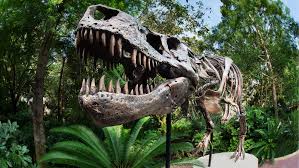A Friday Visit with Jim Korkis: The Fossil Preparation Lab at Disney’s Animal Kingdom
By Dave Shute
Welcome back to Fridays with Jim Korkis! Jim, the dean of Disney historians, writes about Walt Disney World history every Friday on yourfirstvisit.net.
THE FOSSIL PREPARATION LAB
By Jim Korkis
Dino-Sue was named after paleontologist Sue Hendrickson, who found a remarkable skeleton in 1990 at the Cheyenne River Indian Reservation in western South Dakota. Never before had such a complete Tyrannosaurus rex skeleton been unearthed, with about 90 percent of the 350 bones intact.
The original Sue lived during the Late Cretaceous Period, in the Mesozoic Era. She weighed several tons, and her skeleton is a whopping 40 feet long and 13 feet tall, making her the largest Tyrannosaurus rex skeleton ever discovered.
In October 1997, the Chicago Field Museum paid a record $8.4 million for the prehistoric treasure at auction, helped by donations from Walt Disney World, McDonald’s and the California State University system.
Rushing to finish the skeleton for a big millennium exhibit, the Chicago Field Museum had seven people working full time on the bones, including as part of the deal for Disney’s and McDonald’s contributions having three scientists headed by paleontologist Bruce Schumacher who worked on it in the Fossil Preparation Lab in DinoLand.
Millions of visitors observed the preparation of Sue’s bones through glass windows in both labs. The Disney’s Animal Kingdom team (like one in Chicago at the Field Museum) carefully removed the South Dakota rock in which the bones were fossilized 67 million years ago, doing the work behind glass in a public viewing area in the temporary structure.
Every day, a paleontologist worked cleaning, cataloguing and photographing a genuine fossilized dinosaur bone, while a couple of cameras with monitors showed a close up view of the work being undertaken.
“People sometimes have a hard time realizing that these are real bones,” Schumacher said. “We try to go out and talk to people at different times during the day, and sometimes we find that they think we’re just actors pretending to work, on a set made to look like a science lab because it is at Disney.”
Guests could watch through the glass windows, read colorful displays, and ask questions of a Disney attendant stationed outside. In addition, the lab had the sounds of a dinosaur roaring piped in periodically over the loudspeaker. The paleontologists heard it hundreds of a time a day, and would joke that it sounded more like a big toilet flushing than a dinosaur.
The work was tedious. Once cleaned, fragments of the bones were glued together. Any cracks in the bones were filled with industrial-strength Krazy Glue to hold them together and prevent more crumbling. Gaps or missing bones were molded from clay.
In addition, they made molds of the bones so that three replicas could be created. In 1999, the bones were loaded into crates and shipped back to Chicago the same way they arrived: by a special moving company that uses air-conditioned, climate-controlled trucks, the kind used to move fine art. Security guards accompanied the bones. The Fossil Preparation Lab was closed.

(c) Disney
Two of the replicas went on a national tour sponsored by McDonald’s, visiting over 18 U.S. cities beginning in July 2000. The third replica now stands outdoors in DinoLand U.S.A. near the entrance to the Dinosaur attraction.
“This is a chance to have the real thing in DinoLand,” said Bob Lamb, Animal Kingdom’s vice president at the time. “I don’t see us doing a huge promotion about us working on this dinosaur. Sue will become one of the things you discover in the park.”
By the way, the 90-foot Brachiosaurus skeleton that stretches over Dinoland’s entrance was cast from the mold of the same skeleton that arches over Stanley Field Hall in the Field Museum.
* * * * *
Thanks, Jim! And come back next Friday for more from Jim Korkis!
In the meantime, check out his books, including his latest, Disney Never Lands, and about planned but unbuilt concepts, and Secret Stories of Walt Disney World: Things You Never You Never Knew, which reprints much material first written for this site, all published by Theme Park Press.





0 comments
Comment by typing in the form below.
Leave a Comment | Ask a Question | Note a Problem